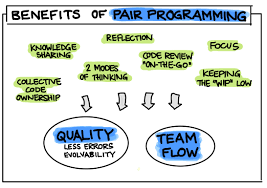In the world of software development, innovation and efficiency are pivotal. Among the various methodologies and techniques, pair programming stands out as a collaborative approach that has been transforming the way code is written, reviewed, and perfected.
What is Pair Programming?
Pair programming is a development technique where two programmers work together at a single workstation. One individual takes on the role of the “driver,” actively writing the code, while the other serves as the “observer” or “navigator,” reviewing each line of code as it’s typed and providing real-time feedback. Roles can switch frequently, fostering continuous collaboration and communication between the two programmers.
Benefits Galore:
1. Improved Code Quality: With two sets of eyes constantly scrutinizing the code, errors and bugs are spotted and resolved more efficiently. The continuous review process leads to cleaner, more maintainable code.
2. Enhanced Problem-Solving: Two minds brainstorming solutions often lead to more innovative and effective approaches to complex problems. Diverse perspectives can uncover solutions that might have been overlooked otherwise.
3. Knowledge Sharing: Pair programming encourages the exchange of knowledge between team members. Novices learn from experienced programmers, and seasoned developers gain fresh insights from different viewpoints.
4. Reduced Bugs and Rework: Identifying and rectifying issues in real-time minimizes the likelihood of bugs creeping into the code base. This proactive approach significantly reduces the need for extensive rework later in the development process.
5. Increased Team Collaboration: Pair programming fosters a culture of collaboration and teamwork within the development team. It promotes open communication and mutual respect for each other’s ideas and skills.
6. Faster Learning Curve: For new team members or those learning a new technology stack, pair programming accelerates the learning process. Working closely with a more experienced programmer helps newcomers grasp concepts faster.
7. Continuous Feedback Loop: Immediate feedback during the development process allows for quick adjustments, ensuring that the code aligns with project requirements and coding standards.
Overcoming Challenges:
While pair programming offers numerous advantages, it’s not without its challenges. Some developers might initially find it uncomfortable or may have concerns about productivity. However, with practice and a supportive team environment, these challenges can be overcome. Setting clear expectations and providing adequate training can help ease the transition.
Conclusion:
Pair programming isn’t just about writing code together; it’s a methodology that promotes collaboration, communication, and continuous improvement. By harnessing the collective intelligence of two programmers, it elevates the quality of the code produced and the skills of the individuals involved. Embracing pair programming can lead to more efficient development cycles, higher-quality software, and a stronger, more cohesive team.
Credits: Babar Shahzad




Well said! Pair programming’s collaborative approach not only enhances code quality but also fosters knowledge sharing and team bonding. It’s exciting to see how such practices can significantly boost learning and innovation in tech teams. #PairProgramming #Teamwork